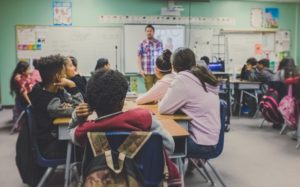As educators, it is our responsibility to provide equal opportunities for all students and do our best to meet the needs of all students despite social, cultural, or economic backgrounds. This may seem like an evident part of teaching, but challenges may arise when moving to an online setting as we discussed in topic 2 the importance of fostering relationships. This week’s readings provide key examples of how to reach out to students and support all in meaningful and relevant contexts.
In chapter 43 of the “Handbook of Research on K-12 Blended Learning Second Edition”, Bashman et al. (2018) discuss the framework of Universal Design for Learning (UDL) which was initially developed as “an approach for ensuring the effective inclusion of students with disabilities and diverse learning needs” but now applies to all learners (p.477). One of the main focus points of UDL is “harnessing technology and instructional practices to remove barriers in curricula and across… learning environments”(Bashman et al., 2018, p.480). The UDL guidelines have been broken down into 3 main principles which help to understand the why, what, and how of learning.
- Multiple means of engagement refers to the “ways to support the affective state and motivational connection to learning”(Bashman et al., 2018, p.483). This may look like giving students autonomy, agency, and motivation with tasks or assignments around the classroom.
- Multiple means of representation refers to the“ways that we sense and perceive information “recognition” networks that occupy the posterior regions of the brain”(Bashman et al., 2018, p.483). An example of this might be adding subtitles to videos so that students who are learning English can read along.
- Multiple means of expression and action refers to the “ways that we organize and execute strategies and actions through executive and motor cortices that occupy the frontal lobes”(Bashman et al., 2018, p.483). A teacher can allow students to represent their learning in a different format such as a video instead of an essay.
Check out this quick video that elaborates on some of the key components of UDL!
In the second reading, Kral and Schwab (2012) discuss the eight design principles taken into consideration when designing a learning environment. The focus of this article is on Indigenous youth in Australia and their “access to resources and a space that is conducive to the enactment of literacy practices” (Kral & Schwab, 2012, p.59). I think this is a critical aspect that Canadian educators must consider as there is a large population of Indigenous students who need a safe place to create, explore, and learn with access to proper resources and supportive teachers. This will ensure equity amongst students as designing an inclusive space can promote collaboration and connection.
The third website looks at how online learning has impacted classrooms during the current Covid-19 pandemic. Slewyn (2020) discusses some of the problems that have arisen over the past several months with a quick adjustment to online learning. He highlights how emotionally challenging online learning can be and how “the limitless and abundant nature of digital technologies, teachers and students are finding that remote online schooling requires clear boundaries in order to be manageable” (Slewyn, 2020). It is easy to be overwhelmed by the capabilities of the internet, but in order to deliver authentic learning experiences, teachers must prioritize the emotional well-being of their students. I hope to learn more about how to teachers find a balance between synchronous and asynchronous learning opportunities in a distributed or open learning environment.
– Ms. G 🙂
Resources
[AHEAD]. (2017, November 2). What is Universal Design for Learning (UDL)? [Video]. YouTube. https://www.youtube.com/watch?v=AGQ_7K35ysA
Basham, J.D., Blackorby, J., Stahl, S. & Zhang, L. (2018) Universal Design for Learning Because Students are (the) Variable. In R. Ferdig & K. Kennedy (Eds.), Handbook of research on K-12 online and blended learning (pp. 477-507). Pittsburgh, PA: Carnegie Mellon University ETC Press.
Kral, I. & Schwab, R.G. (2012). Chapter 4: Design Principles for Indigenous Learning Spaces. Safe Learning Spaces. Youth, Literacy and New Media in Remote Indigenous Australia. ANU Press. http://doi.org/10.22459/LS.08.2012 Retrieved from: http://press-files.anu.edu.au/downloads/press/p197731/pdf/ch041.pdf
Selwyn. N. (2020). Online learning: Rethinking teachers’ ‘digital competence’ in light of COVID-19.[Weblog]. Retrieved from: https://lens.monash.edu/@education/2020/04/30/1380217/online-learning-rethinking-teachers-digital-competence-in-light-of-covid-19


sarahbjelde
Hello Ms. G! What a wonderful read this was. I love how in your first paragraph you mentioned how building relationships is a very important part of safe and equitable learning environments. I also really enjoyed how you broke down the three main principles of UDL—it is always nice to go over these principles again. The video that you embedded in your post was fabulous because of how concise it was and how it really demonstrated the meaning and ideas of UDL. I wish you spoke more on the article by Kral & Schwab since I really enjoyed that one and I know you would have had some fabulous ideas on it. You had a great balance of text, video, and images in this post. I feel like you could have had maybe one more picture to make it more engaging for the reader, though. Great work this week Heather!
alexamclean
Feedback for EDCI 339:
I really enjoy this post! Your clear definitions of the three main principles of UDL with an example of each made everything very clear, especially with your added video. I also liked the mention of the blog and how the online platform can be overwhelming. I have definitely been feeling that over the last few months! I agree with sarahbjelde that I would have liked a bit more detail on the Kral and Schwab article and maybe list the 8 design principles rather than linking the article. Overall, a great post that was a pleasure to read.
laurenmclean
Feedback for EDCI 339:
I have similar ideas to those of my peers. I think your post was great and had a many moments of personal commentary that were insightful and showed a great understanding of empathy and the topics explored this week. I do agree that there could have been more explanation of the ideas from the Karl and Schwab article, but I do think what your idea of creating a “safe place to create, explore, and learn with access to proper resources and supportive teachers” is one that does connect to the ideas of the article and shows that you have an understanding of many of the needs of Indigenous students. I liked how you broke down the three principles of UDL and explained what they are and what they could look like. Also supporting it with the video was a good add! I also found this video and put it in my blog! Overall a great post just maybe reallocating words to more specifics and less commentary in a few places.